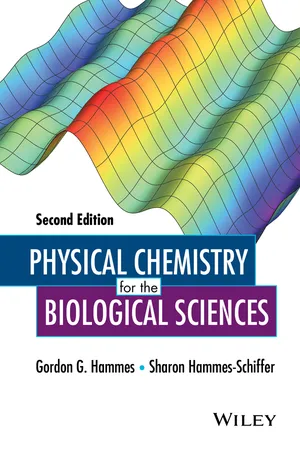
- English
- ePUB (mobile friendly)
- Available on iOS & Android
eBook - ePub
Physical Chemistry for the Biological Sciences
About this book
This book provides an introduction to physical chemistry that is directed toward applications to the biological sciences. Advanced mathematics is not required. This book can be used for either a one semester or two semester course, and as a reference volume by students and faculty in the biological sciences.
Frequently asked questions
Yes, you can cancel anytime from the Subscription tab in your account settings on the Perlego website. Your subscription will stay active until the end of your current billing period. Learn how to cancel your subscription.
No, books cannot be downloaded as external files, such as PDFs, for use outside of Perlego. However, you can download books within the Perlego app for offline reading on mobile or tablet. Learn more here.
Perlego offers two plans: Essential and Complete
- Essential is ideal for learners and professionals who enjoy exploring a wide range of subjects. Access the Essential Library with 800,000+ trusted titles and best-sellers across business, personal growth, and the humanities. Includes unlimited reading time and Standard Read Aloud voice.
- Complete: Perfect for advanced learners and researchers needing full, unrestricted access. Unlock 1.4M+ books across hundreds of subjects, including academic and specialized titles. The Complete Plan also includes advanced features like Premium Read Aloud and Research Assistant.
We are an online textbook subscription service, where you can get access to an entire online library for less than the price of a single book per month. With over 1 million books across 1000+ topics, we’ve got you covered! Learn more here.
Look out for the read-aloud symbol on your next book to see if you can listen to it. The read-aloud tool reads text aloud for you, highlighting the text as it is being read. You can pause it, speed it up and slow it down. Learn more here.
Yes! You can use the Perlego app on both iOS or Android devices to read anytime, anywhere — even offline. Perfect for commutes or when you’re on the go.
Please note we cannot support devices running on iOS 13 and Android 7 or earlier. Learn more about using the app.
Please note we cannot support devices running on iOS 13 and Android 7 or earlier. Learn more about using the app.
Yes, you can access Physical Chemistry for the Biological Sciences by Gordon G. Hammes,Sharon Hammes-Schiffer in PDF and/or ePUB format, as well as other popular books in Biological Sciences & Biochemistry. We have over one million books available in our catalogue for you to explore.
Information
THERMODYNAMICS
Chapter 1
Heat, Work, and Energy
1.1 INTRODUCTION
Thermodynamics is deceptively simple or exceedingly complex, depending on how you approach it. In this book, we will be concerned with the principles of thermodynamics that are especially useful in thinking about biological phenomena. The emphasis will be on concepts, with a minimum of mathematics. Perhaps an accurate description might be rigor without rigor mortis. This may cause some squirming in the graves of thermodynamic purists, but the objective is to provide a foundation for researchers in experimental biology to use thermodynamics. This includes cell biology, microbiology, molecular biology, and pharmacology, among others. A more advanced treatment of some aspects of thermodynamics is presented in Chapter 4. Excellent texts are available that present a more complete exposition of thermodynamics (cf. Refs. (1–3)).
In point of fact, thermodynamics can provide a useful way of thinking about biological processes and is indispensable when considering molecular and cellular mechanisms. For example, what reactions and coupled physiological processes are possible? What are the allowed mechanisms involved in cell division or in protein synthesis? What are the thermodynamic considerations that cause proteins, nucleic acids, and membranes to assume their active structures? It is easy to postulate biological mechanisms that are inconsistent with thermodynamic principles—but just as easy to postulate those that are consistent. Consequently, no active researcher in biology should be without a rudimentary knowledge of the principles of thermodynamics. The ultimate goal of this exposition is to understand what determines equilibrium in biological systems and how these equilibrium processes can be coupled together to produce living systems, even though we recognize that living organisms are not at equilibrium. Thermodynamics provides a unifying framework for diverse systems in biology. Both a qualitative and a quantitative understanding are important and will be developed.
The beauty of thermodynamics is that a relatively small number of postulates can be used to develop the entire subject. Perhaps the most important part of this development is to be very precise with regard to concepts and definitions, without getting bogged down with mathematics. Thermodynamics is a macroscopic theory, not molecular. As far as thermodynamics is concerned, molecules need not exist. However, we will not be purists in this regard: If molecular descriptions are useful for understanding or introducing concepts, they will be used. We will not hesitate to give molecular descriptions of thermodynamic results, but we should recognize that these interpretations are not inherent in thermodynamics itself. It is important to note, nevertheless, that large collections of molecules are assumed so that their behavior is governed by Boltzmann statistics; that is, the normal thermal energy distribution is assumed. This is almost always the case in practice. Furthermore, thermodynamics is concerned with time-independent systems, that is, systems at equilibrium. Thermodyn...
Table of contents
- Cover
- Title Page
- Copyright
- Table of Contents
- Preface to First Edition
- Preface to Second Edition
- THERMODYNAMICS
- CHEMICAL KINETICS
- QUANTUM MECHANICS
- SPECTROSCOPY
- STATISTICAL MECHANICS
- SPECIAL TOPICS
- APPENDICES
- Index
- Methods of Biochemical Analysis
- End User License Agreement